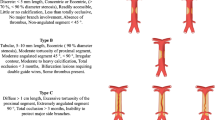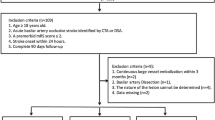Abstract
Objective
This study aimed to summarize the clinical outcomes of endovascular treatment in patients with basilar artery occlusion (BAO) with different pathologic mechanisms.
Methods
Two independent reviewers searched PubMed/MEDLINE, Embase and Cochrane Library database up to December 2022, patients with different BAO pathological mechanisms (BAO with in situ atherosclerosis vs. embolism alone without vertebral artery steno-occlusion vs. embolism from tandem vertebral artery steno-occlusion) were collected and analyzed. We calculated the odds ratios (ORs) and 95% confidence intervals (CIs) to assess the associations between clinical outcomes and BAO pathological mechanisms.
Results
A total of 1163 participants from 12 studies were identified. Compared with embolism alone, patients with in situ atherosclerotic BAO had a lower favorable outcome rate (modified Rankin score [mRS] 0–2: 34.5% vs. 41.2%; OR 0.83, 95% CI 0.70–0.98; P = 0.03) and moderate outcome rate (mRS 0–3: 45.8% vs. 55.4%; OR 0.65, 95% CI 0.47–0.90; P = 0.01) at 3 months and a higher risk of mortality (29.9% vs. 27.2%; OR 1.31, 95% CI 0.96–1.79, P = 0.09; adjusted OR 1.46, 95% CI 1.08–1.96). Tandem BAO had a comparable mortality risk to that of in situ atherosclerotic BAO (OR 1.37, 95% CI 0.84–2.22; P = 0.48) or embolism alone (OR 1.44, 95% CI 0.65–3.21; P = 0.43), and there were no significant differences in favorable or moderate outcomes between tandem BAO and each of the other two BAO mechanisms.
Conclusion
Among BAO patients with endovascular treatment, embolism mechanism had better clinical outcomes than in situ atherosclerosis, and atherosclerotic mechanism was associated with a higher mortality at 3 months. RCTs are needed to further confirm clinical outcomes of BAO by different mechanisms.




Similar content being viewed by others
References
Singer OC, Berkefeld J, Nolte CH et al (2015) Mechanical recanalization in basilar artery occlusion: the ENDOSTROKE study. Ann Neurol 77:415–424. https://doi.org/10.1002/ana.24336
Schonewille WJ, Wijman CA, Michel P et al (2009) Treatment and outcomes of acute basilar artery occlusion in the basilar artery International Cooperation Study (BASICS): a prospective registry study. Lancet Neurol 8:724–730. https://doi.org/10.1016/S1474-4422(09)70173-5
Mattle HP, Arnold M, Lindsberg PJ, Schonewille WJ, Schroth G (2011) Basilar artery occlusion. Lancet Neurol 10:1002–1014. https://doi.org/10.1016/S1474-4422(11)70229-0
Jovin TG, Li C, Wu L et al (2022) Trial of Thrombectomy 6 to 24 hours after Stroke due to basilar-artery occlusion. N Engl J Med 387:1373–1384. https://doi.org/10.1056/NEJMoa2207576
Tao C, Nogueira RG, Zhu Y et al (2022) Trial of Endovascular Treatment of Acute basilar-artery occlusion. N Engl J Med 387:1361–1372. https://doi.org/10.1056/NEJMoa2206317
Weber R, Minnerup J, Nordmeyer H et al (2019) Thrombectomy in posterior circulation stroke: differences in procedures and outcome compared to anterior circulation stroke in the prospective multicentre REVASK registry. Eur J Neurol 26:299–305. https://doi.org/10.1111/ene.13809
Baik SH, Jung C, Kim BM, Kim DJ (2020) Mechanical thrombectomy for Tandem Vertebrobasilar Stroke: characteristics and treatment outcome. Stroke 51:1883–1885. https://doi.org/10.1161/STROKEAHA.120.029503
Sun X, Zhang J, Tong X et al (2022) A comparison between acute large vessel occlusion in the posterior circulation and anterior circulation after endovascular treatment: the ANGEL-ACT registry experience. Stroke Vasc Neurol:svn-2021-001093. https://doi.org/10.1136/svn-2021-001093
Katsumata M, Ota T, Tsuruta W et al (2021) Comparisons of characteristics and outcomes after mechanical thrombectomy for vertebrobasilar occlusion with cardioembolism or atherosclerotic brain infarction: data from the Tokyo-Tama-Registry of Acute Endovascular Thrombectomy (TREAT). World Neurosurg 148:e680–e88. https://doi.org/10.1016/j.wneu.2021.01.071
Pirson F, Boodt N, Brouwer J et al (2022) Etiology of large vessel occlusion posterior circulation stroke: results of the MR CLEAN Registry. Stroke 53:2468–2477. https://doi.org/10.1161/STROKEAHA.121.038054
Yang W, Zhang L, Li Z et al (2021) Endovascular treatment for Acute Basilar artery occlusion: a comparison of arteriosclerotic, embolic and Tandem Lesions. Cardiovasc Intervent Radiol 44:1954–1963. https://doi.org/10.1007/s00270-021-02994-z
Jiang L, Yang JH, Ruan J et al (2021) A single-center experience of endovascular treatment in subtypes of basilar artery occlusion: embolization caused by Tandem Vertebral Artery Stenosis May be Associated with Better Outcomes. World Neurosurg 151:e918–e26. https://doi.org/10.1016/j.wneu.2021.05.011
Sun X, Raynald, Tong X et al (2021) Analysis of treatment Outcome after Endovascular Treatment in different pathological subtypes of basilar artery occlusion: a single Center experience. Transl Stroke Res 12:230–238. https://doi.org/10.1007/s12975-020-00833-w
Abdelrady M, Derraz I, Dargazanli C et al (2022) Outcomes following mechanical thrombectomy in different etiological subtypes of Acute Basilar artery occlusion: Stroke etiology and outcome after EVT in BAO. Clin Neuroradiol Online ahead of print. https://doi.org/10.1007/s00062-022-01217-3
Moher D, Liberati A, Tetzlaff J, Altman DG, Group P (2009) Preferred reporting items for systematic reviews and meta-analyses: the PRISMA statement. PLoS Med 6:e1000097. https://doi.org/10.1371/journal.pmed.1000097
Higgins JP, Thompson SG (2002) Quantifying heterogeneity in a meta-analysis. Stat Med 21:1539–1558. https://doi.org/10.1002/sim.1186
Duval S, Tweedie R (2000) Trim and fill: a simple funnel-plot-based method of testing and adjusting for publication bias in meta-analysis. Biometrics 56:455 – 63. https://doi.org/10.1111/j.0006-341x.2000.00455.x
Baik SH, Park HJ, Kim JH et al (2019) Mechanical thrombectomy in subtypes of basilar artery occlusion: relationship to recanalization rate and clinical outcome. Radiology 291:730–737. https://doi.org/10.1148/radiol.2019181924
Baek JH, Kim BM, Heo JH et al (2019) Endovascular and clinical outcomes of Vertebrobasilar Intracranial atherosclerosis-related large vessel occlusion. Front Neurol 10:215. https://doi.org/10.3389/fneur.2019.00215
Lee YY, Yoon W, Kim SK et al (2017) Acute Basilar artery occlusion: differences in characteristics and outcomes after endovascular therapy between patients with and without underlying severe atherosclerotic stenosis. AJNR Am J Neuroradiol 38:1600–1604. https://doi.org/10.3174/ajnr.A5233
Kim YW, Hong JM, Park DG et al (2016) Effect of intracranial atherosclerotic disease on endovascular treatment for patients with Acute Vertebrobasilar occlusion. AJNR Am J Neuroradiol 37:2072–2078. https://doi.org/10.3174/ajnr.A4844
Piechowiak EI, Kaesmacher J, Zibold F et al (2020) Endovascular treatment of tandem occlusions in vertebrobasilar stroke: technical aspects and outcome compared with isolated basilar artery occlusion. J Neurointerv Surg 12:25–29. https://doi.org/10.1136/neurintsurg-2019-014825
Sefcik RK, Tonetti DA, Desai SM et al (2021) Does stroke etiology influence outcome in the posterior circulation? An analysis of 107 consecutive acute basilar occlusion thrombectomies. Neurosurg Focus 51:E7. https://doi.org/10.3171/2021.4.FOCUS2189
Marto JP, Strambo D, Hajdu SD et al (2019) Twenty-four-hour reocclusion after successful mechanical thrombectomy: Associated factors and long-term prognosis. Stroke 50:2960–2963. https://doi.org/10.1161/STROKEAHA.119.026228
Caplan LR, Wityk RJ, Glass TA et al (2004) New England Medical Center posterior circulation registry. Ann Neurol 56:389–398. https://doi.org/10.1002/ana.20204
Cohen JE, Leker RR, Gomori JM et al (2016) Emergent revascularization of acute tandem vertebrobasilar occlusions: endovascular approaches and technical considerations-confirming the role of vertebral artery ostium stenosis as a cause of vertebrobasilar stroke. J Clin Neurosci 34:70–76. https://doi.org/10.1016/j.jocn.2016.05.005
Funding
This work was supported by 2022jc73 of Wuhu Municipal Science and Technology Bureau, Anhui Province, China.
Author information
Authors and Affiliations
Corresponding author
Ethics declarations
Conflict of Interest
None.
Additional information
Publisher’s Note
Springer Nature remains neutral with regard to jurisdictional claims in published maps and institutional affiliations.
Electronic supplementary material
Below is the link to the electronic supplementary material.
Rights and permissions
Springer Nature or its licensor (e.g. a society or other partner) holds exclusive rights to this article under a publishing agreement with the author(s) or other rightsholder(s); author self-archiving of the accepted manuscript version of this article is solely governed by the terms of such publishing agreement and applicable law.
About this article
Cite this article
Shang, X., Pan, L., Xu, Y. et al. Effect of endovascular treatment on patients with basilar artery occlusion presenting with different pathologic mechanisms: a systematic review and meta-analysis. J Thromb Thrombolysis 57, 124–131 (2024). https://doi.org/10.1007/s11239-023-02884-w
Accepted:
Published:
Issue Date:
DOI: https://doi.org/10.1007/s11239-023-02884-w




